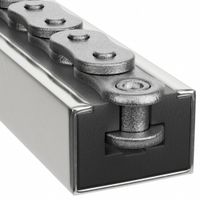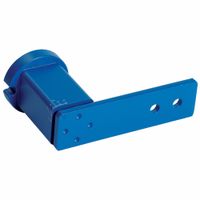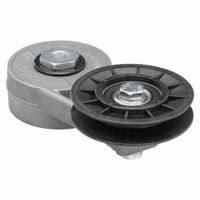Call +(254) 703 030 000 / 751 483 999 / 721 704 777
- Home
- Power Transmission
- Belt Chain Guides Tensioners Tighteners
.....Read More
Frequently Asked Questions
What are belt and chain guides used for in conveyor systems?
Belt and chain guides are critical components in conveyor systems, serving several essential functions to ensure efficient and reliable operation.
1. **Alignment**: Guides help maintain the proper alignment of belts and chains, preventing them from drifting off course. This is crucial for avoiding operational disruptions and ensuring that materials are transported smoothly along the conveyor path.
2. **Stability**: By providing lateral support, guides enhance the stability of the conveyor belt or chain. This stability is vital for preventing the belt or chain from sagging or twisting, which can lead to mechanical failures or damage to the conveyor system.
3. **Wear Reduction**: Guides minimize wear and tear on both the conveyor belt or chain and the system's structural components. By keeping the belt or chain in the correct position, guides reduce friction and abrasion, extending the lifespan of the conveyor system.
4. **Safety**: Properly guided belts and chains reduce the risk of accidents and injuries. Misaligned or unstable conveyor components can pose significant safety hazards, including the potential for materials to spill or the conveyor to malfunction.
5. **Efficiency**: Guides contribute to the overall efficiency of the conveyor system by ensuring smooth and uninterrupted operation. This efficiency is crucial for maintaining high productivity levels and minimizing downtime.
6. **Noise Reduction**: By keeping the belt or chain properly aligned and stable, guides can also help reduce noise levels in the conveyor system, contributing to a quieter and more pleasant working environment.
In summary, belt and chain guides are indispensable for maintaining the alignment, stability, and efficiency of conveyor systems, while also enhancing safety and reducing wear and noise.
How do tensioners prevent belts and chains from slipping?
Tensioners prevent belts and chains from slipping by maintaining the appropriate tension required for optimal operation. They apply a continuous force to the belt or chain, ensuring it remains taut and properly engaged with the pulleys or sprockets. This tension is crucial because it prevents slack, which can lead to slippage, misalignment, or even derailment of the belt or chain.
Tensioners can be automatic or manual. Automatic tensioners use springs, hydraulic systems, or pneumatic systems to adjust the tension dynamically as the system operates. This adaptability is essential for compensating for wear, thermal expansion, or load variations, ensuring consistent performance without manual intervention.
Manual tensioners require periodic adjustment by an operator to maintain the correct tension. This involves physically adjusting the position of the tensioner to take up slack as the belt or chain wears or stretches over time.
By keeping the belt or chain under the right amount of tension, tensioners ensure efficient power transmission, reduce wear and tear, and extend the lifespan of the components. They also help in minimizing noise and vibration, contributing to smoother operation. In summary, tensioners are critical components in mechanical systems, ensuring reliability and efficiency by preventing slippage and maintaining proper alignment.
What are the benefits of using elastomeric tensioners?
Elastomeric tensioners offer several benefits in various applications, particularly in mechanical systems where maintaining consistent tension is crucial.
1. **Vibration Damping**: Elastomeric materials have inherent damping properties that absorb and dissipate vibrations. This reduces noise and wear on mechanical components, leading to longer equipment life and quieter operation.
2. **Flexibility and Adaptability**: These tensioners can accommodate misalignments and variations in tension due to their flexible nature. This adaptability ensures consistent performance even under fluctuating loads or environmental conditions.
3. **Maintenance Reduction**: The self-adjusting nature of elastomeric tensioners minimizes the need for manual adjustments and maintenance. This leads to reduced downtime and lower maintenance costs over the lifespan of the equipment.
4. **Extended Belt Life**: By maintaining optimal tension, elastomeric tensioners reduce slippage and excessive wear on belts. This prolongs the life of belts and other components, enhancing the overall efficiency of the system.
5. **Energy Efficiency**: Proper tensioning ensures that mechanical systems operate at peak efficiency, reducing energy consumption. This is particularly beneficial in systems where energy costs are a significant concern.
6. **Corrosion Resistance**: Elastomeric materials are often resistant to corrosion and chemical exposure, making them suitable for harsh environments where metal components might degrade.
7. **Cost-Effectiveness**: While the initial cost may be higher than traditional tensioners, the long-term savings from reduced maintenance, extended component life, and improved efficiency make elastomeric tensioners a cost-effective solution.
8. **Ease of Installation**: These tensioners are generally easier to install compared to mechanical alternatives, saving time and labor during setup.
Overall, elastomeric tensioners provide a reliable, efficient, and low-maintenance solution for maintaining tension in various mechanical systems.
How do self-adjusting tensioners work?
Self-adjusting tensioners, also known as automatic belt tensioners, are designed to maintain the correct tension in a belt-driven system, such as those found in automotive engines. They ensure optimal performance and longevity of the belt by automatically adjusting to compensate for belt wear, stretching, and other factors that can affect tension.
The core components of a self-adjusting tensioner include a spring mechanism, a pivot arm, a pulley, and a damping system. The spring provides the necessary force to maintain tension on the belt. As the belt stretches or wears over time, the spring allows the pivot arm to move, adjusting the position of the pulley to maintain the correct tension. This automatic adjustment helps prevent slippage, noise, and premature wear of the belt and associated components.
The damping system, often consisting of a hydraulic or friction-based damper, is crucial for controlling the movement of the tensioner. It prevents excessive oscillation and stabilizes the tensioner, ensuring smooth operation even under varying loads and speeds. This damping action is essential for reducing vibrations and noise, contributing to the overall efficiency and reliability of the belt-driven system.
Self-adjusting tensioners are particularly beneficial in modern engines, where space constraints and complex accessory drives make manual tension adjustments impractical. By maintaining consistent tension, these tensioners help improve fuel efficiency, reduce emissions, and extend the life of the belt and other engine components. They are a critical component in ensuring the smooth operation of various systems, including the alternator, power steering pump, and air conditioning compressor.
What is the role of linear tensioners in drive systems?
Linear tensioners in drive systems are crucial components that maintain the appropriate tension in belts or chains, ensuring efficient power transmission and prolonging the lifespan of the drive components. They automatically adjust to compensate for wear, elongation, or thermal expansion, preventing slippage and misalignment. By maintaining optimal tension, linear tensioners enhance the performance and reliability of the drive system, reduce noise and vibration, and minimize the risk of component failure. They are essential in applications where consistent tension is critical, such as in automotive engines, conveyor systems, and industrial machinery.
Why are drive tighteners and shafts important in tensioning devices?
Drive tighteners and shafts are crucial components in tensioning devices because they ensure optimal performance and longevity of mechanical systems. Drive tighteners maintain the correct tension in belts or chains, preventing slippage and ensuring efficient power transmission. Proper tensioning minimizes wear and tear, reducing maintenance costs and downtime.
Shafts, on the other hand, provide the necessary support and alignment for rotating components. They ensure that the tensioning device operates smoothly and efficiently by maintaining the correct alignment and balance. This alignment is critical for preventing vibrations and reducing the risk of mechanical failure.
Together, drive tighteners and shafts contribute to the overall stability and efficiency of tensioning devices. They help in distributing loads evenly, reducing stress on individual components, and enhancing the system's reliability. By maintaining the correct tension and alignment, these components ensure that the mechanical system operates at its optimal capacity, leading to improved performance and extended lifespan.
How do you choose the right tensioner for a conveyor system?
To choose the right tensioner for a conveyor system, consider the following factors:
1. **Conveyor Type and Application**: Identify the type of conveyor (e.g., belt, chain, roller) and its specific application. Different systems have unique tensioning needs based on their design and operational requirements.
2. **Load and Capacity**: Assess the load the conveyor will carry. Heavier loads may require more robust tensioners to maintain proper belt tension and prevent slippage.
3. **Belt Material and Width**: The material and width of the conveyor belt influence the tensioner choice. Ensure compatibility with the belt material to avoid wear and ensure efficient operation.
4. **Environmental Conditions**: Consider the operating environment, including temperature, humidity, and exposure to chemicals or abrasive materials. Choose tensioners made from materials that can withstand these conditions.
5. **Adjustment Mechanism**: Decide between manual or automatic tensioners. Automatic tensioners are suitable for systems requiring constant tension adjustments, while manual tensioners are cost-effective for stable systems.
6. **Space Constraints**: Evaluate the available space for installing the tensioner. Compact tensioners are ideal for systems with limited space.
7. **Maintenance Requirements**: Consider the ease of maintenance and accessibility. Tensioners that are easy to adjust and maintain can reduce downtime and operational costs.
8. **Cost and Budget**: Balance the cost of the tensioner with its features and benefits. Investing in a high-quality tensioner can lead to long-term savings through reduced maintenance and increased system efficiency.
9. **Supplier and Support**: Choose a reputable supplier who offers technical support and after-sales service. Reliable support can be crucial for troubleshooting and maintenance.
By evaluating these factors, you can select a tensioner that ensures optimal performance, longevity, and efficiency for your conveyor system.
What maintenance is required for belt and chain guides?
Maintenance for belt and chain guides involves several key steps to ensure optimal performance and longevity:
1. **Regular Inspection**: Frequently check for signs of wear, misalignment, or damage. Look for fraying, cracks, or unusual wear patterns on belts and chains, and ensure guides are not bent or worn.
2. **Lubrication**: Apply appropriate lubricants to chains to reduce friction and wear. Ensure that the lubricant is compatible with the chain material and operating environment. Belts typically do not require lubrication, but guides may need it to reduce friction.
3. **Tension Adjustment**: Ensure that belts and chains are properly tensioned. Over-tensioning can cause excessive wear, while under-tensioning can lead to slippage. Use tension gauges or follow manufacturer guidelines for correct tension levels.
4. **Alignment**: Check that belts and chains are properly aligned with their guides. Misalignment can cause uneven wear and reduce efficiency. Adjust the position of guides and pulleys/sprockets as needed.
5. **Cleaning**: Keep belts, chains, and guides clean from debris, dust, and contaminants that can cause wear or interfere with operation. Use appropriate cleaning agents that do not degrade the material.
6. **Replacement**: Replace worn or damaged belts, chains, and guides promptly to prevent further damage to the system. Follow manufacturer recommendations for replacement intervals.
7. **Environmental Control**: Ensure that the operating environment is suitable for the materials used. Extreme temperatures, humidity, or exposure to chemicals can affect performance and lifespan.
8. **Documentation**: Maintain records of inspections, maintenance activities, and replacements to track performance and identify patterns that may indicate underlying issues.
By adhering to these maintenance practices, the efficiency and lifespan of belt and chain guides can be significantly enhanced, reducing downtime and repair costs.
How do tensioners reduce friction and wear in conveyor systems?
Tensioners play a crucial role in reducing friction and wear in conveyor systems by maintaining optimal belt tension. Proper tension ensures that the conveyor belt runs smoothly over pulleys and rollers, minimizing slippage and misalignment. This reduces the friction between the belt and the conveyor components, which in turn decreases wear and tear.
By keeping the belt taut, tensioners prevent excessive sagging, which can lead to increased contact with the conveyor structure and result in higher friction. This sagging can also cause the belt to rub against the sides of the conveyor, leading to abrasion and premature wear. Tensioners help maintain a consistent belt path, reducing lateral movement and the associated friction.
Moreover, tensioners help in distributing the load evenly across the belt. Uneven load distribution can cause localized stress and increased friction in certain areas, leading to accelerated wear. By ensuring uniform tension, tensioners help in mitigating these localized stresses.
Tensioners also contribute to the longevity of conveyor components such as bearings and rollers. Proper belt tension reduces the load on these components, minimizing the friction they experience during operation. This not only extends their lifespan but also reduces maintenance costs and downtime.
In summary, tensioners reduce friction and wear in conveyor systems by maintaining optimal belt tension, preventing slippage, minimizing sagging, ensuring even load distribution, and reducing stress on conveyor components. This leads to smoother operation, increased efficiency, and longer service life for the conveyor system.
What are the differences between manual and automatic tensioners?
Manual tensioners require manual adjustment to maintain the correct tension in a belt or chain system. They rely on the operator's skill and experience to set the tension accurately. Manual tensioners are typically more cost-effective and simpler in design, making them easier to install and maintain. However, they require regular monitoring and adjustment to ensure optimal performance, which can be time-consuming and may lead to human error.
Automatic tensioners, on the other hand, adjust the tension automatically using a spring-loaded mechanism or hydraulic system. They maintain consistent tension by compensating for wear, temperature changes, and other factors that can affect belt or chain tension. Automatic tensioners reduce the need for regular maintenance and adjustments, improving system reliability and performance. They are generally more expensive and complex than manual tensioners but offer greater precision and convenience.
In summary, manual tensioners are cost-effective and simple but require regular manual adjustments, while automatic tensioners offer consistent tension with minimal maintenance but are more expensive and complex.






